
.22 BPCR Silhouette range at Graham, Texas
Although it was 2010, when the .22 Black Powder Rifle Association was officially formed, there was considerable interest in .22 competition with the “old style” rifles long before that. The .22 Black Powder Cartridge Silhouette competitions have gained significant momentum since 2010. Now, the .22 BPCR silhouette game has eclipsed big-bore black powder cartridge rifle shooting in many parts of the country. Many of us “old timers” have found refuge in the low recoil of the 22 Long Rifle cartridge and off-the-shelf ammo. In recent years, more shooters have participated in the .22 BPCR Silhouette National Championships than in the BPCR National Championships. According the to the .22 Black Powder Cartridge Association website (
22bpcra.com), there are 12 gun clubs in Texas, Kansas, Oklahoma, Wyoming, Nevada, Arkansas, Idaho, Arizona, Tennessee, and Pennsylvania that are affiliated with the .22 BPCR Association. The .22 BPCRA is not affiliated with the National Rifle Association, but rather is governed and funded solely by those who compete in the sport.
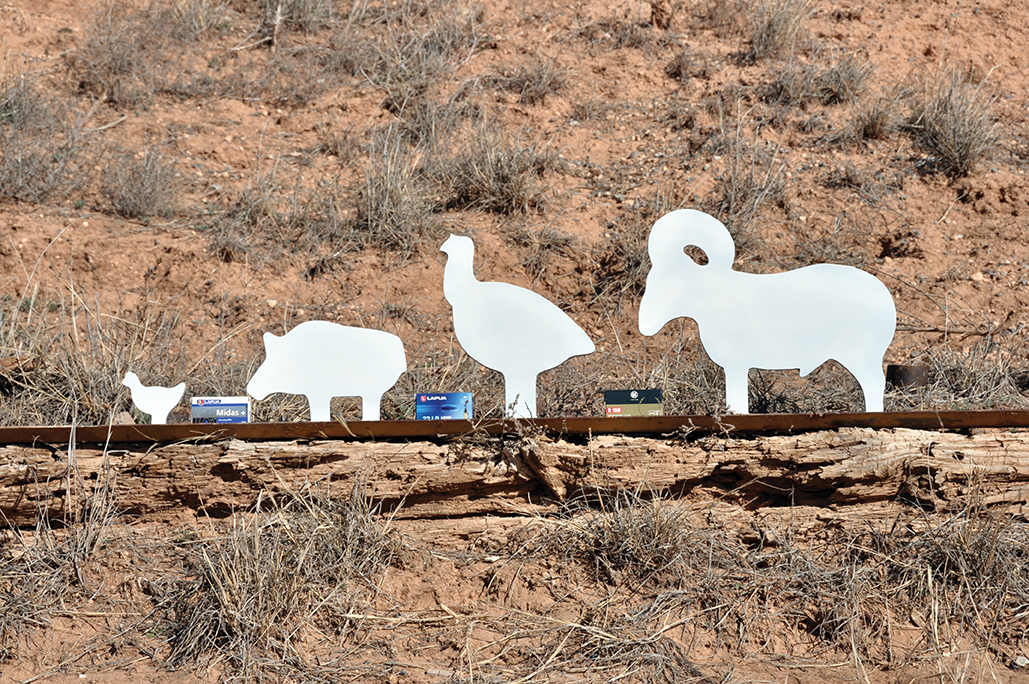
Reduced size .22 BPCR targets.
The name “.22 Black Powder Cartridge Silhouette” is kind of a misnomer since .22 caliber cartridges loaded with black powder are not available. I personally do not know of anyone who has attempted to load their own .22 caliber ammunition with black powder. However, never say never; there are “diehards” among us. The .22 BPCR Silhouette game is essentially an extension of, or “off-shoot” (no pun intended) of big-bore BPCR. The .22 game got its start directly from centerfire black powder cartridge rifle competition, and it was the big-bore shooters who came up with the idea of using the same rifles, rules, and targets for .22 competition in the first place. There is a long list of people who contributed and deserve credit for transforming .22 BPCR Silhouette from a just a “good idea” to becoming a reality. The late Dave Crossno from Oklahoma, was one of the first people to produce barrel liners so a centerfire rifle could be converted to a .22 caliber rimfire rifle. At the time, there were no .22 caliber silhouette matches being held. Crossno’s idea was to use barrel liners to practice off hand shooting for those who did not have access to a 200-meter rifle range. Then, as .22 caliber matches were starting to be held, Dan Zimmerman from Oklahoma City, started producing very accurate and beautiful .22 caliber Hepburn rifles. There were countless others who contributed to .22 BPCR silhouette evolution as well, however, two Texas shooters, David Barnes and Ken Tebbe deserve the lion’s share of credit for the establishment of the sport and holding national championships. Without their leadership, there is no question that .22 BPCR Silhouette would not be where it is today. My hat is off to all those who contributed to what is now a very viable and active shooting sport.
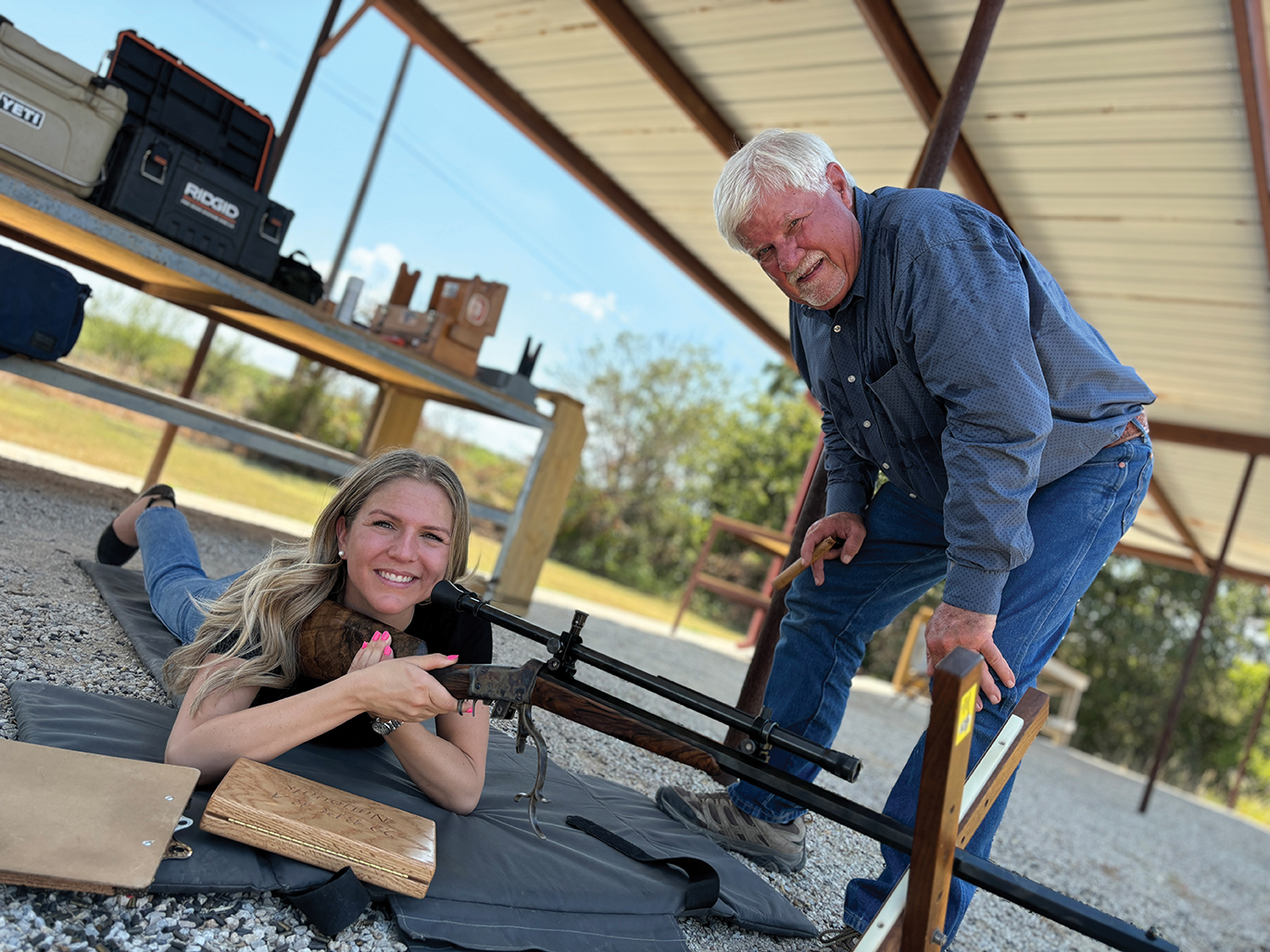
Daughter-in-law’s first .22 BPCR Silhouette competition.
Rules that govern .22 BPCR Silhouette can be found on the association’s webpage (www.22bpcra.com). Any original or replica single shot rifle originally made for black powder cartridges of United States manufacture prior to 1896, are permitted. This era of rifles all have an exposed hammer. In addition, barrel liners that convert a centerfire black powder cartridge rifle to a rimfire .22 long rifle caliber are also permitted. The same iron sights or scopes allowable in big bore competitions are also allowed in .22 competition. Rifles most commonly seen in the .22 caliber black powder cartridge competitions include the Remington Hepburn, the Winchester 1885 Single Shot rifle (both in High Wall and Low Wall configurations), and Ballard rifles. Almost all of the rifles built up on original actions have been re-barreled with modern barrels made by Douglas, Lilja, Bartlein, Green Mountain, Krieger, or Shilen.
At our gun club in Graham, Texas, we allow those who wish to compete with modern bolt action or semi-auto .22 caliber rifles equipped with high power scopes to do so. These shooters compete in a separate class from those shooting the traditional single shot rifles. Some who are reading this may frown on this idea, however; the separate class works very well and does not pose a problem. Allowing these competitors to shoot in our monthly matches helps generate extra funds for our club. This also allows the traditional single shot competitors with eight to 10X scopes to compare how their rifles stack up against the highly accurate and “tricked out” CZ 457’s and Voodoo bolt action rimfire competition rifles that are equipped with 12 to 30X scopes. I might add, it is not often that they beat those shooting the traditional rifles!
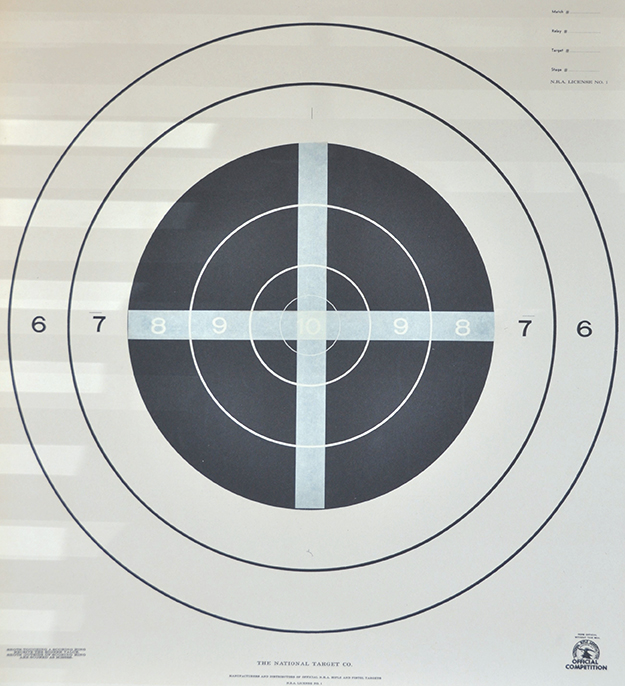
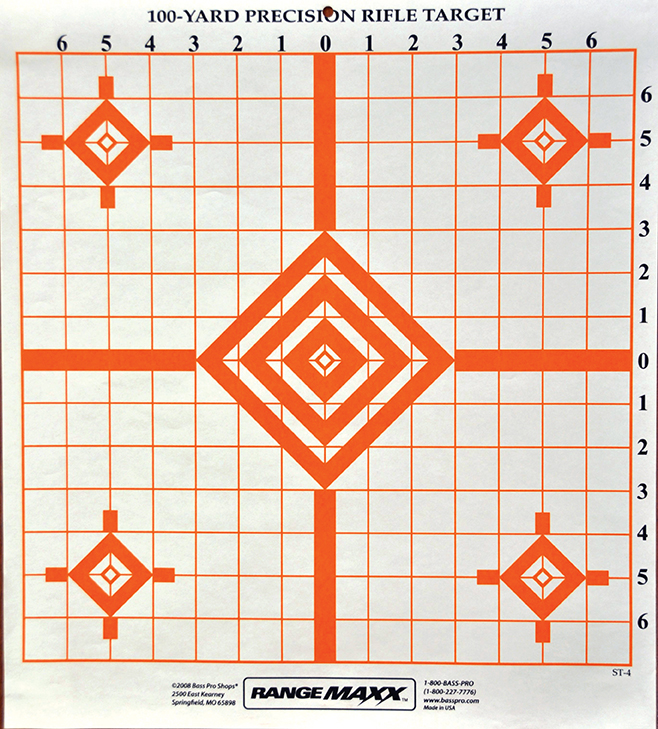
Preferred 100-Yard test targets.
The steel targets for .22 competitions are the same as big-bore; chickens, pigs, turkeys and rams, albeit they are smaller in size and placed closer than for big-bore competition. For .22 silhouette competition the chicken, pig, turkey, and ram target distances are 50, 100, 150 and 200 meters, respectively. The number of targets per match are essentially the same as in big-bore and can include 40, 60 and 80-shot matches. The amount of time allotted for sighters and engaging targets is shorter than in centerfire competition. For a typical 40-shot match, shooters have a 15-second “ready” and eight minutes to shoot unlimited sighters and their 10 targets for score.
So, what’s the upside? First, .22 BPCR Silhouette competition is a perfect alternative for those who are interested in silhouette competition without being incumbered with casting bullets, loading ammunition, and shooting a heavy-recoiling rifle. The positive things we enjoy about big-bore competition are still there with .22 BPCR silhouette; those being marksmanship, testing of accurate ammunition, calling wind, improving ones shooting skills and being able to shoot as a team with a spotter. Finally, .22 silhouette is fun and provides shooters with a new challenge.
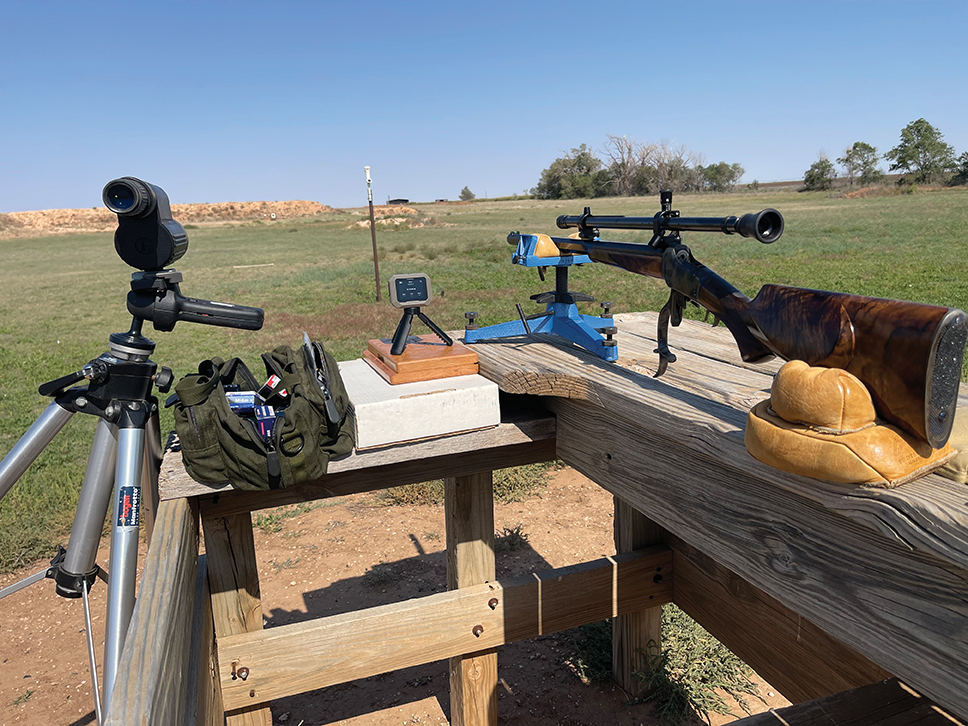
100-yard benchrest position.
In August of last year, I had the opportunity to capitalize on the fun aspect of .22 silhouette when my son and daughter-in-law asked to participate in one of our club matches. Although my son and I have shot centerfire BPCR silhouette matches together in the past, his work currently prohibits him from a deep dive into big-bore BPCR at this stage in his life. My daughter-in-law, however, is a tiny girl, weighing in at about 100 pounds; she could not tolerate the recoil of a 45-70 silhouette rifle. They both drove in from Arizona and participated in one of our club matches at Graham, Texas. We went to the range a day early and I taught my daughter-in-law how to shoot from cross sticks, how to load the rifle, how to set the triggers, and how to make scope adjustments. Safety and proper gun handling were taught as well. We also covered trigger control and how wind affects the bullet impact on target. Before long, she understood and could adapt to “holding on” and “holding off” when a major scope adjustment was not called for. This was her very first match; she shot a 29 and that was with only one chicken! Needless to say, this will be one of those times I will always cherish and remember. Later my son questioned his wife on what she did to shoot so well. Her answer was “when I was on that rifle, I didn’t so much as move an eyelash!”
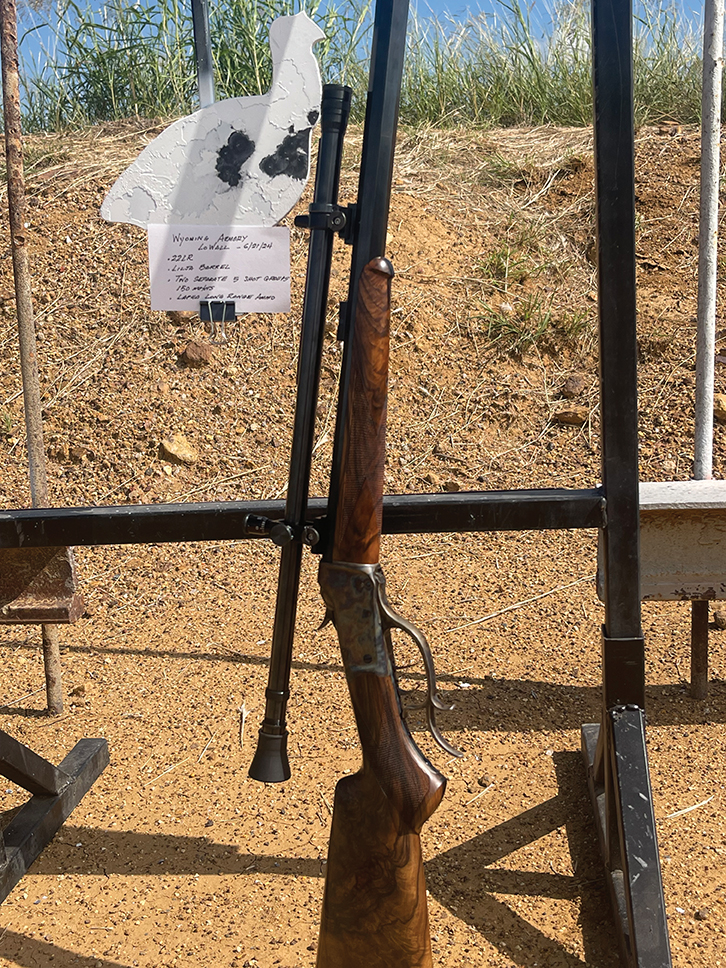
Turkey group shooting – two separate five-shot groups at 150 meters.
So, what’s the upside – part two? For me anyway, it is all about shooting accurate rifles and the steps necessary for achieving that goal. I am obsessed with accuracy. I’m never satisfied and I never feel like I have reached the “end game” when it comes to accuracy. Even when I shoot good groups with a particular brand or lot of ammo, I always remember the bad groups I shot with that same brand or lot of ammo.
When I took up .22 BPCR Silhouette, other than having a barrel with potential for a high level of accuracy, I knew that finding accurate .22 caliber ammunition was going to be the key to achieving high scores. But it wasn’t until I started putting shots on paper and chronographing loads, that I fully realized how much difference there really is in the accuracy potential of different brands of .22 caliber ammunition. Finding .22 caliber ammo that will consistently shoot an inch or less at 100 yards requires a lot of testing. I also came to realize that just because a box of .22 ammunition may be branded by name as “target” or “match”, means absolutely nothing.
In my quest to find the most accurate .22 caliber ammunition possible, I had two obstacles to overcome. The first was my expectation for accuracy potential. I shot an awful lot of high-end and expensive .22 caliber ammunition from two or three different rifles before I finally accepted the fact that “minute of angle” is considered to be very accurate for the rifles we shoot.

.22 Caliber ammunition tested.
Second, achieving good shot-to-shot target acquisition was the second obstacle. I have struggled with this especially since I am in my mid 70’s and my eyesight is not as good as it was 20 years ago. I have tried many different types and colors of commercially available targets and found that a black target with a horizontal and vertical strip of ¾-inch wide white masking tape across the black target area gives me the clear shot-to-shot hold (see photo below). I also have used and like the orange colored “100-Yard Precision Rifle Targets” made by Range Maxx. These targets are available at Cabela’s and Bass Pro Shops. Your groups will be no better than your ability to hold center from one shot to the next.
After much trial and error, I found that a testing procedure was necessary for determining which brands and lots of .22 long rifle ammunition will perform the best in any given rifle. It is not at all uncommon for two different rifles with identically branded barrels to prefer different brands or lots of ammo. And, if you run out of a given brand of good shooting ammo (and you can’t find a supply of the same ammo with the same lot number) you are going to have to start testing all over again. So, if you once find a brand or lot of ammo that shoots good in your rifle, better buy a lot of it.
Testing at 50 yards will not tell you very much about the accuracy potential of various brands or lots of ammunition. Depending on your criteria for acceptable accuracy, most brands of .22 caliber ammunition will shoot pretty good at 50 yards. If you only test at 50 yards and attempt to draw conclusions based on the results, you will be disappointed in what you see at 100 yards and beyond. I don’t waste expensive ammunition by shooting at 50 yards.
All of the .22 caliber ammunition testing I do is at 100 yards and beyond. However, 100 yards is my starting point. I can separate the good from the bad at this distance. At 100 yards, I shoot on a paper target and I chronograph each load. The rifle is equipped with an MVA 8 or 10X scope and the shooting will be from a sandbagged and benchrest position. Each group usually consists of 10 shots. Pertinent information such as the date, the rifle, the distance to target, the ammunition and lot number, and wind conditions will be written on the target, and then I take a photo of the group with my cell phone. When I change from one brand of ammunition to the next, I clean the bore with Rimfire blend cleaning solvent, dry the bore with a clean patch and shoot five fouling shots off target. Cleaning between different brands of ammunition is necessary since each brand of ammo may use a different type of lube on the bullet. Group shooting at 100 yards is repeated over and over again and on different days until I am satisfied that a particular brand or lot of ammo is a consistent performer.
It is also necessary to test .22 long rifle ammunition at distances beyond 100 yards. On match weekends, I drive down to our silhouette range one day early, and this is where I shoot groups at 150 and 200 meters. I only have the ability to shoot out to 100 yards at my local range, so all distance shooting is conducted at our club range in Graham, Texas. All distance shooting, is done from a prone and cross stick position and consists of 10 shots per load on silhouette target swingers. I do not chronograph loads when shooting at turkeys and rams, but I do follow the same cleaning and barrel fouling procedures that I described when shooting at 100 yards.
When shooting at longer distances, wind conditions can be a significant factor in trying to achieve tight groups. Since winds are seldom calm in Texas, I normally hold “on or off” in an attempt to compensate for changing wind when testing ammo on turkey and ram swingers. Other than learning how to “value” changing wind conditions, there will be days where it is just too windy to evaluate accuracy potential of your ammunition. However, on calm days or just light wind, the attached photo illustrates how shooting at longer distances can be of value in building confidence in your ammo. On the day this target was shot, the wind was light, however, small corrections were needed on some shots. The first five shots hit on the right side of the turkey. For the next five shots, I adjusted the scope two minutes left and fired the next five shots, holding just a little off or a little on based on wind.
Chronograph data helps confirm “that which I believe to be true”. If two or more different brands of ammo shoot close to the same groups, chronograph data is useful in drawing conclusions about accuracy potential. And, on more than one occasion I have seen a particular brand of ammo that did not shoot as well anticipated. Chronograph data can help sort out why. I have included a chart of chronograph data from 10 brands of .22 caliber ammunition to illustrate this point. For each brand of ammunition, 10 shots were fired across the chronograph. The shooting and chronographing took place on two different days; October 16, 2024, for the budget ammunition and on October 23, 2024, for the expensive competition ammunition. As it turned out, wind conditions were problematic on both days. Even though the groups were disappointing, I am including them in this article. Wind was gusty and generally blowing toward two and three o’clock on both days, so horizontal stringing was inevitable. Also, I had just purchased a Garmin Xero C1 chronograph and I was anxious to try it out.
The ammo included in the attached table was selected to compare “budget” match ammunition to expensive match or competition ammunition. The budget ammo ranges in cost from 18 to 22 cents per round and includes: Wolf Match Extra (made by Eley), CCI Standard Velocity, SK Long Range Match, and Eley Benchrest Semi-Auto Precision ammunition. The competition quality and/or expensive ammo includes all of the Lapua brands, RWS R 100 and Eley Match. The “high end” ammo ranges in cost from 32 to 47 cents per round. I had never chronographed .22 caliber ammunition, so I was very anxious to find out how different brands compared ballistically. Did the costlier ammunition really have significantly better stats? And if so, how much better?

With one exception, smaller 10-shot groups and better statistical data was obtained from the expensive ammunition as compared to the budget ammunition. The Eley Benchrest Semi Auto Precision ammo had excellent statistics and it shot a decent group that measured 1.25 wide by 1.25 tall. It is interesting to note that Eley developed this ammunition for semi-auto rifle platforms. I learned about the Eley Benchrest Semi Auto Precision ammunition by watching one of the “JP Enterprises” YouTube videos where the challenges of developing their AR .22 caliber rifle was discussed. JP Enterprises produces AR rifles in a multitude of calibers that are capable of delivering match grade accuracy for those who compete with this style rifle. John Paul, the owner of JP Enterprises stated in the YouTube video that this particular brand of ammunition proved to be a turning point in aiding in the development of the JP AR .22; I decided to give it a try. This ammunition had the second lowest standard deviation of 5.1 and extreme spread of 13.5 of all 10 brands of ammunition. As of yet, I haven’t passed final judgment on the Eley Semi-Auto Benchrest Precision ammunition because I have not tested beyond 100 yards. However, it seems to have promise, especially, at the 21 cents per round price point.
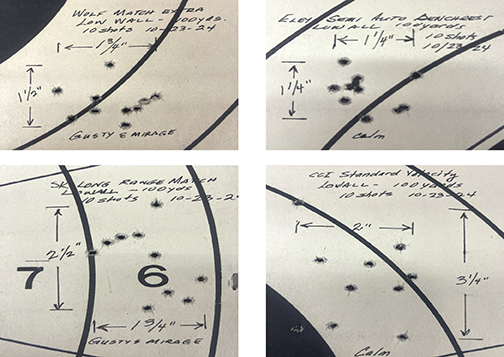
Budget Brands of .22 Caliber Ammunition.
The SK Long Range ammunition and the CCI Standard Velocity groups were 1.75-inch to 3.25 inches. Not good and the stats weren’t good either. The extreme spread was 31.6 and 33.4 for SK and CCI, respectively, and standard deviations were 9.4 to 11.5. The group for the Wolf Match Extra group was smaller than the SK and CCI but the stats were about the same. I have tested Wolf Match Xtra several times, in three different silhouette rifles and found it to be an erratic performer. I think it is safe to conclude from these test targets and the statistical data that the budget or low cost, “match” ammunition, performed poorly, with Eley Semi Auto Benchrest precision ammunition being the possible exception.
The four Lapua brands in this chart are often mentioned as the “ammunition of choice” by bolt action competitors; all four had similar statistics. Midas +, Long Range, and Super Long Range have always performed well in my rifles, especially Midas +. This was the first time I had ever tried the Lapua Center X, so I had no expectations one way or the other. It does, however, have a good reputation for accuracy among many bolt action benchrest shooters. Considering the wind conditions at the time I was shooting these groups, Lapua Long Range, Midas +, and Super Long Range performed pretty well. Center X was disappointing; however, it was a windy day when these groups were shot.
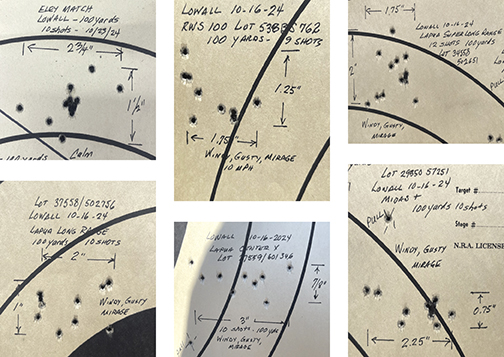
Test Targets – Competition Quality .22 Caliber Ammunition.
The RWS R 100 is my “go to” ammo for competition. In my rifles, this ammunition holds up extremely well at all distances and is a consistent performer. The 10-shot group I achieved on this day of shooting does not at all reflect the accuracy potential of RWS R 100. I have shot numerous sub-minute of angle groups with RWS R 100. The extreme spread of 12.9 and a remarkably low standard deviation of 3.9 was the lowest by far of all the ammunition tested. It is interesting to note that the RWS R 100 delivered the highest average velocity of all brands tested. Velocity was between 61 and 78 feet per second faster than the Lapua brands. Unfortunately, it is questionable whether RWS R 100 will continue to be imported into the United States in the future; at least that’s what I hear from dealers that specialize in selling high-end .22 caliber ammunition.
The Eley Match ammunition performed “so-so” in this test; and that has been my past experience with Eley Match. Some days I can get minute of angle groups with Eley Match and other days groups are large. This ammunition has been unexplainably inconsistent in my rifles. The stats for Eley match were okay, but fell behind RWS R 100 and the Lapua ammunition.
Those of us who shoot and compete in big-bore black powder cartridge competition are probably among some of the most hardcore shooters on the planet. We, as a group, like the nostalgia of the old singe shot and exposed hammer guns, and we embrace the challenge to make them shoot accurately. The .22 BPCR Silhouette game is no different. The fun is there, the challenge is there, and the nostalgia is there. Plus this sport lends itself to endless opportunities to get women and kids involved. It is all good!













